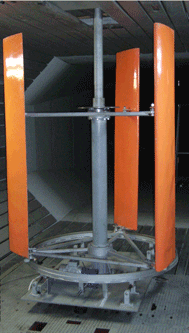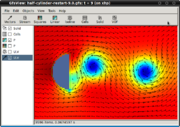THE INSTITUTE NEEDS YOUR HELP
IHM NASU was damaged by the attack of rashist drones
COMPUTER HYDROMECHANICS, 2024 (Program, Abstracts)
IX International Scientific & Practical Conference "Computer Hydromechanics"
A WIND TURBINE WITH A VERTICAL ROTOR AXIS
AND BLADE CONTROL MECHANISM
 |
Wind power turbines with a vertical axis of rotation have several advantages in comparison with conventional (horizontal-axis) facilities. At the same time, high wind flow velocity necessary for the self-starting of the rotor and a low energy flow utilization rate are known as significant drawbacks of this design concept when rotor blades are rigidly fixed. The control of the position of wind rotor blades on their trajectory can drastically reduce the importance of these shortcomings. In late 1990s, a simple in arrangement mechanism for controlling of vertical blades of a wind turbine was proposed and patented by our Institute. Since 2002, the systematic experimental studies of several models of such device were carried out in a hydrotray of the IHM NASU. In 2006–2007, a prototype of the 1 kW wind-power unit with a vertical axis of rotation was designed and manufactured together with the "Prodmash Plant" (Melitopol, Zaporizhzhya region) and tested in the wind tunnel of the National Aviation University. Its blades have two axes at the lower end. The front one is installed on the front the rotor’s horizontal cross bar, and the back one contacts with the control ring which center can move along the line of wind flow action from the center of rotation, thereby creating a certain eccentricity. The obtained results have shown that optimization of the blade control mechanism allows the manifold increasing in the energy flux and torque usage, as well as reduction of total pressure drop and hydro-aerodynamic load pulsations on the shaft of the rotor. Currently, the Department of Information Systems in Hydroaeromechanics and Ecology is developing the more sophisticated models wind-power rotors with a vertical axis of rotation. |





